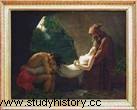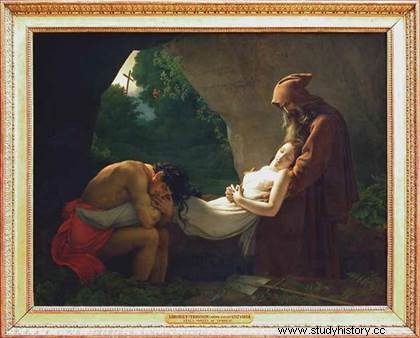 “Atala in the Tomb or “Atala’s Funeral » is a painting of two meters by two meters sixty executed by the painter Girodet in 1808 and exhibited at the Louvre Museum. Inspired by Christian iconography, the painting represents three characters present at the entrance to a cave, at sunset:Chactas, the overwhelmed lover, who holds the knees of Atala the young girl who has not not given to him. Helped by Father Aubry, they bury him...
“Atala in the Tomb or “Atala’s Funeral » is a painting of two meters by two meters sixty executed by the painter Girodet in 1808 and exhibited at the Louvre Museum. Inspired by Christian iconography, the painting represents three characters present at the entrance to a cave, at sunset:Chactas, the overwhelmed lover, who holds the knees of Atala the young girl who has not not given to him. Helped by Father Aubry, they bury him...
The painter Girodet
Anne Louis Girodet de Roussy-Trioson, although a student of David, moved away from history painting for a more sentimental vision and adopted the painting of romanticism. For this work, he is inspired by the novel by Chateaubriand published in 1801 "Atala or the loves of two savages in the desert", taking place in America in the century of Louis XIV. The origin story is different:the Indian and the hermit dig with their hands a tomb for a poor girl. The novel celebrates the Catholic religion, the innocence of primitive peoples, exoticism:everything is found in this painting. Girodet therefore innovates with this style of painting, in opposition to David's style.
The exhibition of this painting at the Salon of 1808 was a great success, practically one of the only successes of Girodet's career. Bought by a journalist opposing the Empire, the painting was appreciated by Chateaubriand and admired by Baudelaire. Châteaubriant's novel is emulated, eighteen paintings on Atala will be made in France.
Atala in the tomb:the symbolism

Atala in the Tomb, by Girodet, Louvre Museum
Atala, the young Indian convert to Christianity, fell madly in love with Chactas. After fleeing through the forest, they meet the hermit Aubry who wants to unite them. But Atala had promised her mother to remain a virgin, and despite her love for Chactas, she ends her life by poisoning herself. Main character, Atala seems to be sleeping. His body seems light and not rigid. Her skin is radiantly white. Dressed in a simple sheet, carrying a cross in her hand, her face is nevertheless unreal for a corpse. It represents purity, ideal beauty, a kind of sensuality:all the ingredients of romanticism.
Chactas is desperate, but brave and handsome like the warriors of Greco-Roman times. In a cave, at sunset, a symbol of the end of the young girl's life, Father Aubry, dressed in a homespun robe, holds Atala's upper body. Helped by Chactas, both feet in the pit, they are ready to bury the young girl. On the stone wall is engraved "I have passed like a flower, I have dried up like the grass of the fields".
This impossible, romantic love, which was to dominate the 19th century, represents passionate sacrifice, the struggle between the spiritual values of faith and the sensual values of love…because that Atala made a profession of faith and virginity, but because she loves…she must die. Everything in this work is only internalization of feelings, there is no spectacle effect, but a very great silent pain. The colors, the clarity on the body of Atala make this painting curiously very alive, despite death!
To go further
- Girodet:1767-1824, collective work. Gallimard, 2005.
